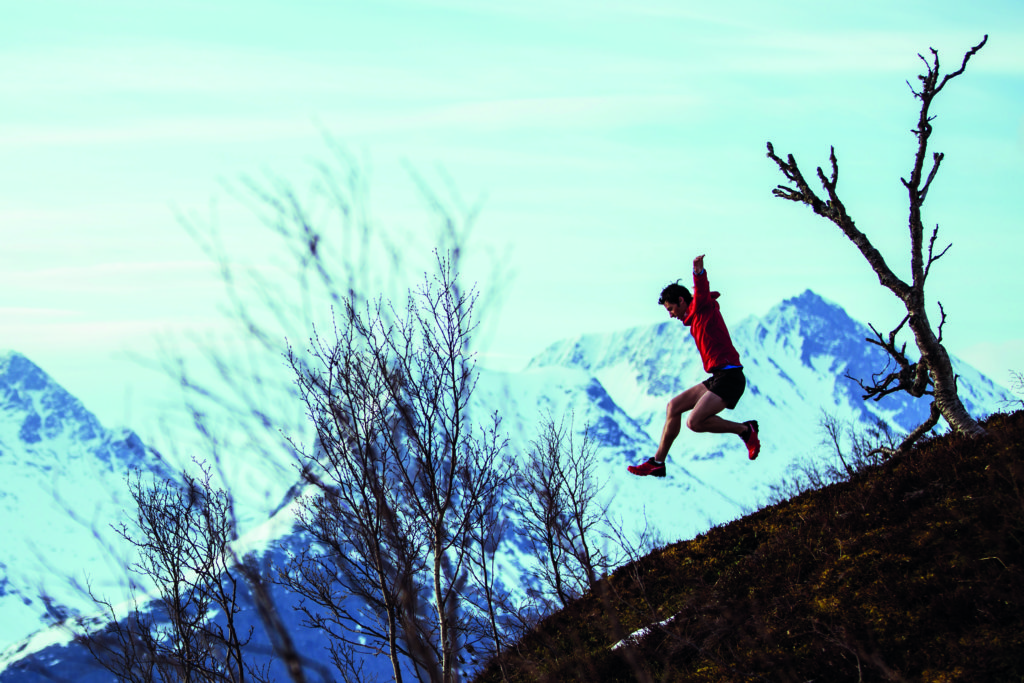Few would dispute that Spaniard Kilian Jornet is the greatest mountain runner on the planet. Dominic Bliss reveals five reasons why he’s so good
1) Lungs
Brought up in the Pyrenees, Kilian is of course used to the low oxygen levels at high altitude. Nature and nurture have given him an incredibly high maximal oxygen uptake – a VO2 max of between 87 and 92 mL/(kg·min), close to that of champion road cyclist Miguel Indurain and cross-country skier Bjorn Daehlie, two of the highest-measured athletes during their peak (the average untrained male has 35 to 40 ml/kg/min).
Kilian’s lungs aren’t particularly large (5.3 litres in capacity), just extremely efficient. “At altitude it’s more about how you breathe and how you use the oxygen,” he explains. “If you have six litres of capacity but can only use four litres in the muscles, it doesn’t work. The important thing is to use all the oxygen that you breathe in.”
2) Legs
Given his slight build (171cm/ 5ft 7ins tall; 58kgs/ 9 stone 1lb in weight), Kilian has very muscly legs. His calves measure 39cms around, his quads 46cms.
“Going uphill this can handicap me a bit because muscle is heavy but you need to have the power to push your body up. Going down, you need the power of muscles for the impact.
The marathon runners who come to mountain running can run fast on the flat but when it’s steep they can’t run for long because they don’t have big leg muscles.”
Kilian also has very large ankles for his body size. “They are naturally big – my parents have big ankles,” he says. “But it is also from when I was a kid, outside and running a lot. I have never twisted my ankles or feet which is a very common injury for mountain runners.”
3) Eyes
Kilian has normal 20:20 vision but the coordination between his eyes and his legs is off the scale. Incredibly, one of his training techniques in this area is to run downhill, memorise the terrain coming up, close his eyes, and continue running blind for distances of up to 50 metres.
“What’s important is the connection between your vision and the movement of your muscles,” he says. “You don’t look exactly where you are placing your feet. You look at the trail ahead of you and memorise the trail so that you place your feet in the right place.”
This obviously takes years of practice. How far ahead Kilian looks depends on how technical the trail is. “If it’s a really technical trail, then I look 10 metres in front. If it’s an easy trail, maybe 50 metres.”
4) Heart
Given the risks that elite mountain runners take, you might describe Kilian as something of a lionheart. Yet even he confesses to feeling fear. “It’s important to have fear because fear keeps you alive. If you have no fear you go for everything and you die. But at the same time, to improve, you must take risks. I am realistic about the risks I take. I know what I can do and what I can’t do.”
Surprisingly, Kilian says he doesn’t enjoy adrenalin in areas outside of skiing or mountain running. “Actually I like the calm. Normally, for me it’s more about reading, writing, more peaceful things. If you take risks every day, it’s like you are playing the lottery. Eventually you will win, and if you win you’re in trouble.”
Unbelievably, aside from a couple of broken teeth, Kilian has never had a serious injury in either skiing or running. He once broke his patella but that was in the street, coming home from school.
5) Body Mass
Look at Kilian’s body and it’s obvious his body mass index is pretty impressive. In a normal training period he has eight per cent fat and 47 per cent muscle. Hardly surprising when you consider that, in an average year, he trains for 1,000 hours, covering (both on foot and on skis) 15,000K, and climbing 550,000 metres in total elevation.







